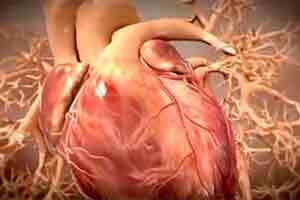Study: Heart Attacks, Stroke at Work Often Follow Vigorous Physical Activity
Firefighters who died of heart attacks and other vascular problems such as stroke while on the job were most often doing vigorous physical activity right before the attack, according to a study released today that will be presented at the American Academy of Neurology’s 66th Annual Meeting in Philadelphia.
 “Knowing that these fatal heart attacks and other vascular events occur relatively frequently, fire departments and other workplaces need to be prepared to recognize these events and screen for those who may be at higher risk,” said study author Amna Zarar, MD, a researcher at Zeenat Qureshi Stroke Institute in St. Cloud, Minn.
“Knowing that these fatal heart attacks and other vascular events occur relatively frequently, fire departments and other workplaces need to be prepared to recognize these events and screen for those who may be at higher risk,” said study author Amna Zarar, MD, a researcher at Zeenat Qureshi Stroke Institute in St. Cloud, Minn.
For the study, the researchers gathered data from the National Institute for Occupational Safety and Health that had been received by the Centers for Disease Control and Prevention from 1998 to 2012 on deaths that occurred while firefighters were on duty. The data collected rated the activities the firefighters were engaged in prior to the cardiovascular event as either “light to moderate” or “vigorous.”
There were 199 fatal cardiovascular events while firefighters were on duty. Of those, 167 were heart attacks, 12 were from irregular heartbeat, three were from stroke, with the rest from other cardiovascular causes. A total of 148 of the events occurred after vigorous activity lasting an average of 33 minutes. The firefighters who died were an average of 49 years old and had served an average of 22 years as firefighters. CPR was performed for 178 of the firefighters, and an external defibrillator was used for 151 of them.
A total of 88 of the firefighters were actively engaged in fighting a fire at the time of the cardiovascular event, Zarar said. At least 61 were responding to an emergency. About 35 percent of the events occurred at the fire station, triggered by fitness training or lifting heavy fire hoses or other equipment.
Zarar said screening for those at high risk of heart attack or other events should include tests for high cholesterol, blood sugar tests for diabetes and stress EKG tests. “People also need more awareness of the symptoms and signs that can precede or occur with a heart attack or stroke,” Zarar said, “along with better screening for risk factors with regular health check-ups.”
Of the 148 firefighters who were engaged in vigorous physical activity at the time of the event, 94 had high cholesterol, 93 had high blood pressure, 42 were smokers, 22 had diabetes and 46 had family members with heart disease.
Of the 51 firefighters who were engaged in light to moderate physical activity at the time of the event, 38 had high blood pressure, 34 had high cholesterol, 20 were smokers, seven had diabetes and 11 had family members with heart disease.
Source Newsroom: American Academy of Neurology (AAN)
Citations
AAN Annual Meeting April 2014


